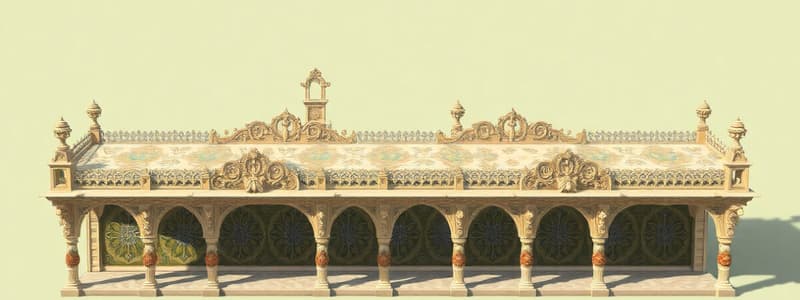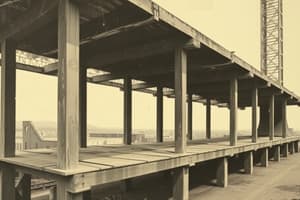Podcast
Questions and Answers
What is the primary bending direction of one-way slabs?
What is the primary bending direction of one-way slabs?
- Both axes equally
- Short axis
- Long axis (correct)
- None of the above
One-way slabs have an aspect ratio less than 2:1.
One-way slabs have an aspect ratio less than 2:1.
False (B)
Name two types of slabs mentioned.
Name two types of slabs mentioned.
One-way slab and two-way slab
One-way slabs are defined with an aspect ratio in plan of ___ or greater.
One-way slabs are defined with an aspect ratio in plan of ___ or greater.
Match the type of slab to its description.
Match the type of slab to its description.
What is the classification of slabs that are supported on all four sides and have an L/S ratio less than 2?
What is the classification of slabs that are supported on all four sides and have an L/S ratio less than 2?
Bending in two-way slabs occurs in a linear form.
Bending in two-way slabs occurs in a linear form.
What type of reinforcement is required in two directions for two-way slabs?
What type of reinforcement is required in two directions for two-way slabs?
Two-way slabs are defined as those with an L/S ratio less than _____ and supported on all four sides.
Two-way slabs are defined as those with an L/S ratio less than _____ and supported on all four sides.
Match the following characteristics with the type of slab:
Match the following characteristics with the type of slab:
What is the primary function of carpenter's formwork?
What is the primary function of carpenter's formwork?
A slab sitting on a beam is typically considered to have a fixed support.
A slab sitting on a beam is typically considered to have a fixed support.
What material is commonly used to build formwork on site?
What material is commonly used to build formwork on site?
The term __________ is given to molds into which concrete is poured.
The term __________ is given to molds into which concrete is poured.
Match the components with their descriptions:
Match the components with their descriptions:
What is the primary purpose of slabs in construction?
What is the primary purpose of slabs in construction?
Slabs are not used for pre-stressing in structural components.
Slabs are not used for pre-stressing in structural components.
What structural feature is commonly applied to slabs?
What structural feature is commonly applied to slabs?
Slabs are used to provide flat and useful __________.
Slabs are used to provide flat and useful __________.
Match the following terms with their descriptions:
Match the following terms with their descriptions:
What is the primary dimension of slab S1?
What is the primary dimension of slab S1?
The thickness of slab S1 is 300 mm.
The thickness of slab S1 is 300 mm.
What is the secondary dimension of slab S1?
What is the secondary dimension of slab S1?
The slab S1 is supported by beams b1 and b2, which are supported by column pairs C2, C4 and C1, C3 respectively. The thickness of slab S1 is _____ mm.
The slab S1 is supported by beams b1 and b2, which are supported by column pairs C2, C4 and C1, C3 respectively. The thickness of slab S1 is _____ mm.
Match the following elements to their roles in the structure:
Match the following elements to their roles in the structure:
Which of the following types of slabs curves under loads in one direction only?
Which of the following types of slabs curves under loads in one direction only?
A two-way slab can only be supported by beams in one direction.
A two-way slab can only be supported by beams in one direction.
What are the two categories of solid slabs?
What are the two categories of solid slabs?
A ___ slab is supported by four beams and can curve under loads in different directions.
A ___ slab is supported by four beams and can curve under loads in different directions.
Match the type of slab with its characteristic:
Match the type of slab with its characteristic:
Flashcards
Slab
Slab
A flat structural element typically used to provide a horizontal, load-bearing surface.
Pre-stressing
Pre-stressing
A technique used to enhance the strength of concrete structures by applying tensile forces.
Use of Concrete Slabs
Use of Concrete Slabs
Concrete slabs are often used in construction because they provide a flat, stable, and useful surface for various purposes.
Concrete Slabs and Pre-stressing
Concrete Slabs and Pre-stressing
Signup and view all the flashcards
Advantages of Pre-stressing Slabs
Advantages of Pre-stressing Slabs
Signup and view all the flashcards
One-way slab
One-way slab
Signup and view all the flashcards
Two-way slab
Two-way slab
Signup and view all the flashcards
Aspect ratio of a slab
Aspect ratio of a slab
Signup and view all the flashcards
Waffle slab
Waffle slab
Signup and view all the flashcards
Flat slab
Flat slab
Signup and view all the flashcards
Two-way Slab Bending
Two-way Slab Bending
Signup and view all the flashcards
Two-way Slab Reinforcement
Two-way Slab Reinforcement
Signup and view all the flashcards
L/S Ratio
L/S Ratio
Signup and view all the flashcards
L/S < 2
L/S < 2
Signup and view all the flashcards
What is the primary dimension of a slab?
What is the primary dimension of a slab?
Signup and view all the flashcards
What is the secondary dimension of a slab?
What is the secondary dimension of a slab?
Signup and view all the flashcards
What is a beam in construction?
What is a beam in construction?
Signup and view all the flashcards
What is the purpose of columns in construction?
What is the purpose of columns in construction?
Signup and view all the flashcards
What is a slab in construction?
What is a slab in construction?
Signup and view all the flashcards
Pinned support
Pinned support
Signup and view all the flashcards
Formwork
Formwork
Signup and view all the flashcards
Timber formwork
Timber formwork
Signup and view all the flashcards
Casting concrete
Casting concrete
Signup and view all the flashcards
Stripping formwork
Stripping formwork
Signup and view all the flashcards
Solid Slab
Solid Slab
Signup and view all the flashcards
Ribbed Slab
Ribbed Slab
Signup and view all the flashcards
Study Notes
One-Way and Two-Way Slabs
- Slabs are important structural components, particularly where pre-stressing is used.
- They provide flat, usable surfaces.
- One-way slabs have an aspect ratio of 2:1 or greater in the plan.
- Bending primarily happens along the longer axis.
- If ribs are only in one direction, the slab is considered one-way.
- A one-way slab is determined by L/S > 2 (where L is length and S is the shorter dimension).
- One-way slabs can be solid, hollow, or ribbed.
- Two-way slabs bend in two directions, commonly in a dish-like form.
- Two-way slabs usually have supports on all sides.
- Two-way slabs have L/S < 2 to be classified a two way slab.
- Two-way slabs are commonly found in buildings supported by beams under the edges of the slab.
Types of Slabs
- Flat plates: Do not have beams between columns, but may have spandrel beams at the edges.
- Flat slabs: Have no beams, but might have drop panels or column capitals.
- Two-way slabs with beams: Contain beams between the columns.
- If the beams are wide and shallow, they are called band beams.
- For larger span construction, ribs might be used in both spanning directions of the slab, creating a waffle slab.
Loading and Application of One-Way Slabs
- Slabs supported on two opposite sides only induce loads perpendicular to the supporting beams.
- If supports are provided on all sides, most load is carried along the shorter direction to the supporting beams, resulting in one-way action.
One-Way Slab Layout and Application
- Useful in architectural situations with limitations.
- The simplest slab design.
- Main reinforcement is placed in one direction, with less congestion than two-way slabs.
Simply Supported One-Way Slabs
- Structural frames have four columns, two beams, and one slab.
- One-way slabs are supported by two beams.
Formwork for One-way Slabs
- Carpenter's formwork is temporary wooden molds for pouring concrete.
- It is constructed onsite from timber.
- Formwork drawings are designed for carpenter implementation and installer steel reinforcement placement.
Slab S1 (Example)
- Slab S1 is 180 mm thick.
- The primary dimension is 4.40 m, secondary is 8.0 m.
- It is supported by column pairs (C2, C4 and C1, C3).
- Supports are typically pinned (when a slab sits on a beam).
Two-way Slabs
- A two way slab is one that spans in two direction.
- If more beams are added, the slab becomes two way.
Advantages of Flat Plates and Flat Slabs
- Simpler formwork
- Reduced obstructions for service conduits
- Flexible interior layouts and future refurbishments.
Waffle Slabs
- Used for long span construction.
- Ribs are used in both directions for support
One-Way vs. Two-Way Ribbed Slabs
- One-Way: Ribs in one direction
- Two-Way: Ribs in two directions
Studying That Suits You
Use AI to generate personalized quizzes and flashcards to suit your learning preferences.





